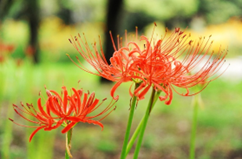Equinox
Yoshie Doi

I offered ohagi and alcohol, as well as my parents’ favorite food, red rice and fruit. Equinox is the day when we think of our families and ancestors in the afterlife. In 2023, the fall equinox will begin on September 20th, Chunichi on September 23rd, and the autumn equinox will end on September 26th.
The vernal and autumnal equinoxes are the days when the sun rises due east and sets due west, and the length of day and night are approximately the same.The custom of visiting graves on the equinox is related to this sun. The dates of the vernal and autumnal equinoxes are determined by the movement of the sun, according to calculations by the National Astronomical Observatory of Japan. The vernal equinox is defined as the day when the sun’s ecliptic longitude reaches 0 degrees, and the autumnal equinox is defined as the day when the sun’s ecliptic longitude reaches 180 degrees.
On the days of the vernal and autumnal equinoxes, it is believed that the energies of the other world and this world are almost equal, and on the days when the equinox and this shore connect, it is believed that the equinox and this shore become the easiest to communicate with, and people began to hold memorial services for their ancestors. Japanese people have cherished the twice-yearly equinox.
The huge structure with dug pillars at the Sannai Maruyama ruins has twin pillars that correspond to the sunrise and sunset of the vernal and autumnal equinoxes, and it is believed that the sun rises from the top of Mt. Fuji in the east and sets at Izumo Taisha Shrine in the west. It has been. The equinox was said to be to the west, and this shore to the east. Since ancient times, there has been a culture of thinking about this world and the next.
In Buddhism, the other world, the world of enlightenment reached by crossing the ocean of birth and death, is called the “Equinox”, and the other side, the real world where we live, full of earthly desires, is called “Shigan”.
It is said that the roots of Ohigan date back to the Asuka period, when Prince Shotoku was there. It became an annual event of the Imperial Court during the Heian period. This event is also mentioned in The Tale of Genji and Kagero’s Diary. In China, people also visit graves on the equinox.
The current custom of visiting graves on the equinox began in the mid-Edo period. On the equinox, we visit graves and offer flowers, incense, etc., and pray to our ancestors with our daily gratitude.
Equinox is a world free from earthly desires that are the source of human confusion and suffering, and means “world of enlightenment” in Sanskrit.
In order to arrive from the world of earthly desires, “this shore” (this world), to the world of enlightenment, “Higan”, during the period of Equinox, even those who are not practicing Buddhism must sink to the west in order to eliminate earthly desires. It is said that he prayed to the sun. This is because the equinox was said to be to the west and this bank to the east.
I suddenly remembered that the philosopher Tetsuo Yamaori often talked about this through the children’s song “Yuyake Koyake.” Humans are attracted to what lies beyond the sunset.
Kyoto also has a history related to the sun. It is well known that the Tadasu no Mori of Shimogamo Shrine and the Gentadasu of Uzumasa’s Silkworm Shrine are located on the line from Mt. Hiei where the morning sun of the summer solstice shines from Mt. Hiei. I am impressed by the wonders of the Japanese people, who have been sensitive to the movement of the sun since ancient times. On the morning of the summer solstice, the morning sun shines through Mt. Hiei, so the name is said to have its roots in Mt. Hie.
It is understandable that the relationship between the equinox, the sun, and astronomy is involved in Japanese customs.
The end of document
